#bhaktiyoga
Text

83 notes
·
View notes
Text

Lotus Feet
#krishna#krsna#lotusfeet#vrindavan#yamuna#bhakti#bhaktiyoga#yoga#prema#longings#rasa#shelter#meditation#heart#heartofmyheart#life and soul
11 notes
·
View notes
Text

History of the universe
#god#lord#Vishnu#Krishna#Hindu#Hinduism#divine#books#scripture#good vibes#cosmos#beautiful#Bhakti#bhaktiyoga
107 notes
·
View notes
Text
Verse 12.17 - Bhakti Yoga
यो न हृष्यति न द्वेष्टि न शोचति न काङ्क्षति ।शुभाशुभपरित्यागी भक्तिमान्यः स मे प्रियः ॥
He who neither rejoices, nor hates, nor grieves, nor desires. Renouncing good and evil, full of devotion, he is dear to Me.
The meaning of this verse is that the devotee who is free from attachment and aversion to the dualities of life, such as pleasure and pain, gain and loss, honor and dishonor, etc., and who has surrendered all his actions to the Will of God, is very dear to the Lord. Such a devotee does not seek any personal benefit from his actions, nor does he lament for any loss or hanker for any gain.
He is content with whatever comes his way, and remains steadfast in his devotion to the Lord. He does not judge his actions by their worldly outcomes, but by their conformity to the divine law. He is not affected by the good and evil results of his actions, but renounces them both, offering them to the Lord. He is thus free from the bondage of karma, and attains the Supreme Peace (the Peace that passeth all understanding!) and Bliss of the Lord.
Similar verses from other Vedic texts are:
- Yogavashishta 6.2.215.6:
मोक्षोपायानिमान्पुण्यान्प्रत्यक्षानुभवार्थदान् ।बालोप्यकर्ण्य तत्ज्ञात्वं याति का त्वादृशे कथा ॥
Having learnt the methods of Realization, expounded in this work which brings about direct intuition; Even a child comes to Realize the Self, what to speak of you who are like that.
This verse from the Yogavashishta praises the efficacy of the teachings of this text, which are based on the non-dualistic philosophy of Advaita Vedanta. It says that anyone who listens to and understands the methods of Realization taught in this text, can attain the direct Realization of the Self, which is the Ultimate Goal of human life. It implies that the seeker who is already endowed with the qualifications of discrimination, detachment, and devotion, can easily achieve this goal by following the instructions of this text.
- Mundaka Upanishad 3.1.4:
नायमात्मा प्रवचनेन लभ्यो न मेधया न बहुना श्रुतेन । यमेवैष वृणुते तेन लभ्यस्तस्यैष आत्मा विवृणुते तनूं स्वाम् ॥
This Self cannot be attained by instruction, nor by intellectual power, nor by much hearing. He whom the Self chooses, by him the Self can be attained. The Self reveals His own Form to him.
This verse from the Mundaka Upanishad declares that the Self cannot be attained by mere verbal or intellectual means, such as listening to lectures, reading books, or reasoning. The Self is beyond the reach of the senses and the mind, and can only be realized by the Grace of the Self. The Self chooses the one who is sincere, earnest, and devoted, and reveals His own nature to him. The seeker who has purified his mind and heart, and who has surrendered to the Self, becomes fit for this revelation.
- Katha Upanishad 2.1.11:
नाविरतो दुष्चरितान्नाशान्तो नासमाहितः ।नाशान्तमानसो वाऽपि प्रज्ञानेनैनमाप्नुयात् ॥
He who has not turned away from evil conduct, who is not tranquil, who is not composed; Who is not peaceful in mind, cannot attain Him by knowledge.
This verse from the Katha Upanishad emphasizes the importance of ethical and moral conduct, as well as mental discipline, for the attainment of the Self. It says that the one who is still engaged in evil actions, who is restless, agitated, and disturbed, who is not calm and serene in mind, cannot attain the Self by mere knowledge. Knowledge here means the intellectual understanding of the scriptures, which is not enough to Realize the Self. The seeker must also practice the virtues of truthfulness, non-violence, self-control, compassion, etc., and cultivate the qualities of concentration, meditation, and devotion, to prepare his mind for the Realization of the Self.
5 notes
·
View notes
Text


Hare Krsna
#girl#mine#me#love#cute#yogini#yogi#hippie#yoga asanas#yogacommunity#bhakti#bhagavadgita#devotional service#chanting#mahamantra#bhagavad gita#yoga blog#yoga teacher#narada bhakti sutras#bhaktiyoga#devotees
37 notes
·
View notes
Text
#GodMorningThursday
Supreme God ....
Until we attain true spiritual
practice of supreme god kabir saheb Ji, we have to endure both good
and bad deeds.
Download our Official App "Sant Rampal Ji Maharaj
#SantRampajiQuotes
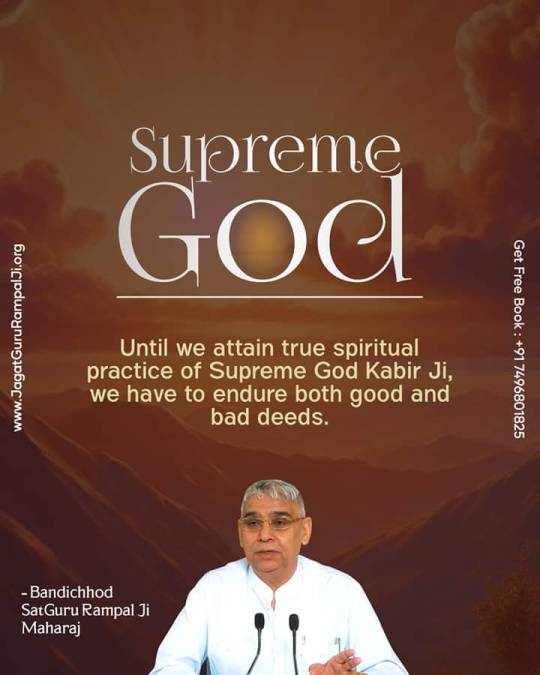
#kabirisgod#spiritual#satlok#enlightenment#worship#devotional#bhaktiyoga#indianhistory#saintrampalji
2 notes
·
View notes
Photo
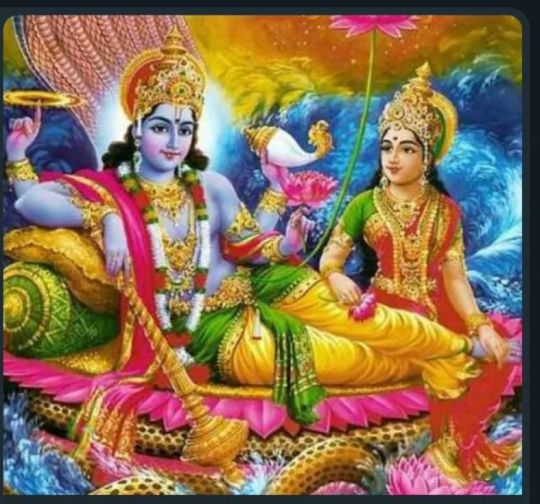
ॐ नारायणाय विद्महे, वासुदेवाय धीमहि। तन्नो विष्णु प्रचोदयात्"।।* आज बैसाख माह के शुक्ल पक्ष की एकादशी, 'मोहिनी एकादशी" दिन गुरुवार है। गुरुवार के दिन भगवान श्री विष्णु को शंख से अभिषेक करके पीले पुष्प अर्पित करते हुए तुलसी, आँवला चढ़ाने से समस्त भौतिक, सांसारिक सुखों की प्राप्ति होती है। आज मोहिनी एकादशी है। इस एकादशी का व्रत करने, इस दिन भगवान श्री विष्णु जी की पूजा करने से सहस्त्रों गौ दान का फल मिलता है। एकादशी के दिन भगवान विष्णु के साथ मां लक्ष्मी की पूजा करने से धन-धान्य की कोई कमी नहीं रहती है। एकादशी के दिन चावल खाना दुर्भाग्य को बुलावा देना है। जीवन में सुख, समृद्धि और सफलता हेतु एकादशी का व्रत करिए अपनी मनोज झा अनुसार जो पॉसिबल हो दान धर्म भक्ति पूजा पाठ करें मन को साफ रखी है शरीर को स्वस्थ रखिए प्राणी मात्र का सम्मान करिए पशु पक्षी गौ रक्षा सेवा भाव मनसे सेवा करिए। #bhakti #krishna #harekrishna #god #india #love #hindu #mahadev #hinduism #vrindavan #iskcon #radheradhe #bhaktiyoga #shiva #radhakrishna #radhekrishna #yoga #lordkrishna #haribol #spirituality #spiritual #meditation #radharani #mahakal #radha #radhe #harharmahadev #bhagavadgita #devotion #instagram https://www.instagram.com/p/CdcjJ2VP8A-/?igshid=NGJjMDIxMWI=
#bhakti#krishna#harekrishna#god#india#love#hindu#mahadev#hinduism#vrindavan#iskcon#radheradhe#bhaktiyoga#shiva#radhakrishna#radhekrishna#yoga#lordkrishna#haribol#spirituality#spiritual#meditation#radharani#mahakal#radha#radhe#harharmahadev#bhagavadgita#devotion#instagram
16 notes
·
View notes
Text

Bhakti Yoga | Hare Krishna Melbourne
Bhakti Yoga is a spiritual practice of yoga; meaning that learning how to to become a practitioner requires more than just physical practice. Truly undertaking the practice of bhakti yoga requires beginners to immerse themselves in the practice and philosophy of Bhakti yoga. To begin learning how to practice bhakti yoga and maintain a vedic lifestyle, there are four principles you should start with: association, books, chanting, and diet.
0 notes
Text

Kirtan Meditation | Hare Krishna Melbourne
Discover inner peace and harmony through the ancient practice of Kirtan meditation in Melbourne. Join our serene gatherings, experience soulful chants, and uplift your spirit. Beginners welcome. Visit our website or call @ 6139699 5122.
0 notes
Text

Bhakti Yoga | Hare Krishna Melbourne
Bhakti Yoga is a spiritual practice of yoga; meaning that learning how to to become a practitioner requires more than just physical practice. Truly undertaking the practice of bhakti yoga requires beginners to immerse themselves in the practice and philosophy of Bhakti yoga. To begin learning how to practice bhakti yoga and maintain a vedic lifestyle, there are four principles you should start with: association, books, chanting, and diet.
https://www.harekrishnamelbourne.com.au/bhakti-yoga/
0 notes
Text
Happy Mahashivratri 2024: Wishes, Status, And Messages
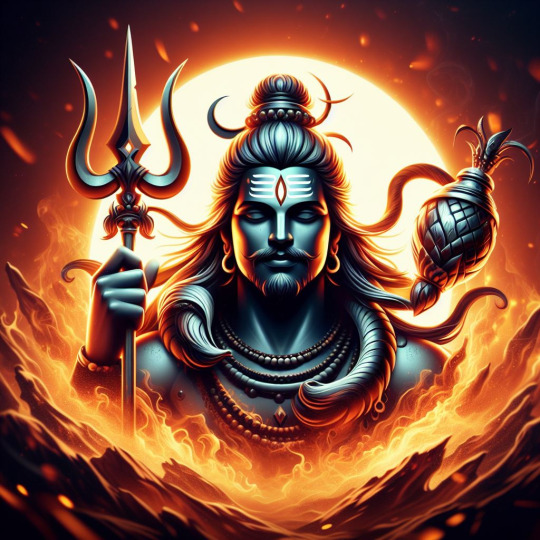
Unveiling Mahashivaratri: A Night of Celebration and Devotion
Mahashivaratri, literally translating to "The Great Night of Shiva," is one of the most significant Hindu festivals, observed annually with immense devotion and grandeur across India and the world. This festival falls on the 14th day of the dark fortnight (Krishna Paksha) in the Hindu lunar month of Phalguna, which typically corresponds to February or March in the Gregorian calendar.
Unveiling Mahashivaratri: A Night of Celebration and Devotion
Unveiling the Significance of Mahashivratri: A Night of Deep Devotion
Unveiling the Legends of Mahashivratri: Divine Dance and Celestial Union
Spiritual Practices of Mahashivratri: Fasting and Staying Awake (Jagran)
Unveiling the Rituals of Mahashivratri: A Night of Devotion and Offerings
Seeking Inner Peace: Meditation and Spiritual Practices on Mahashivratri
Unveiling the Diverse Expressions of Mahashivratri: Across Traditions and Regions
Unveiling the Yogic Connection: Mahashivratri and the Path to Self-Realization
Unveiling the Artistic Expressions of Mahashivratri: A Night of Melodies and Movement
A Taste of Devotion: Festive Cuisine on Mahashivratri
The Spirit of Togetherness: Social and Community Aspects of Mahashivratri
Mahashivratri: A Global Celebration of Lord Shiva
Mahashivratri in the Digital Age: Embracing Technology for a Connected Celebration
Honoring Shiva and Protecting Nature: Eco-Friendly Celebrations on Mahashivratri
Unveiling the Inner Journey: Mahashivratri as a Catalyst for Reflection and Renewal
Mahashivratri: A Timeless Celebration of Devotion, Transformation, and Unity
FAQs Based on Mahashivratri
The Celebration of Shiva
Mahashivaratri honors Lord Shiva, one of the supreme deities in Hinduism. He represents transformation, destruction (to pave the way for creation), and the preserver of the universe. Celebrations on this night vary across regions, but all center around paying homage to Lord Shiva. Devotees observe fasts, participate in elaborate pujas (prayers), chant mantras (sacred chants), and stay awake throughout the night offering prayers.
Read the full article
#AdiShankara#Adiyogi#Aghori#AmarnathYatra#Ardhanarishvara#ArdhanarishvaraForm#AshesoftheDead#AumNamahShivay#BaelLeavesOffering#BhaktiRas#BhaktiSangeet#BhaktiSatsang#BhaktiYoga#Bhang#BhasmaAarti#BhasmaTilak#BhavaSamadhi#Bhimashankar#BholeNath#CosmicDance#CosmicEnergy#CosmicGrace#CosmicVibration#CulturalFestivities#CulturalHarmony#Damaru#Devotee'sLove#Devotee'sOfferings#Devotion#DevotionalChants
0 notes
Text

#bhakti#srilaprabhupada#spirituality#yoga#bhaktiyoga#narasimha#hare krishna#krishnaconsciousness#cow
44 notes
·
View notes
Text
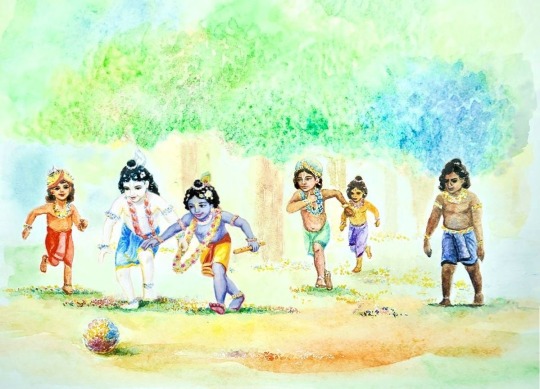
Krishna and Balaram and the cowherd boys
#boys#pleasure#rama#playingfootball#football#Vrindavana#sakhas#bhaktiyoga#bhakti#vrindavan#yoga#krsna#krishna
16 notes
·
View notes
Text
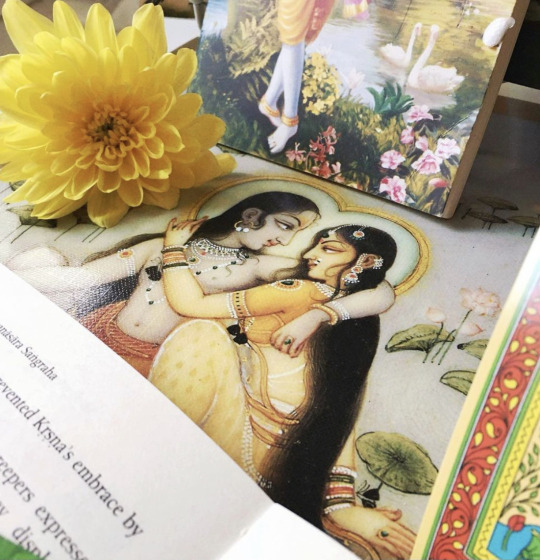
The lord on earth as Krishna and Radha
29 notes
·
View notes
Text
The Bhagavad Gita Verse 13.4
तत्क्षेत्रं यच्च यादृक्च यद्विकारि यतश्च यत् |
स च यो यत्प्रभावश्च तत्समासेन मे शृणु ||
Listen and I will explain to you what that field is and what its nature is. I will also explain how change takes place within it, from what it was created, who the knower of the field of activities is, and what his powers are.
- The field (kshetra) refers to the body-mind complex, which is the object of perception and experience for the individual soul (jiva). The field is composed of the five elements, the five senses, the five organs of action, the mind, the intellect, the ego, and the three modes of material nature (gunas). The field is constantly undergoing change and transformation due to the influence of time, karma, and the gunas.
- The knower of the field (kshetrajna) refers to the Supreme Self (atman), which is the Witness and the substratum of the field. The knower of the field is distinct from the field, and is not affected by its modifications. The knower of the field is the same in all beings, and is the Source of Consciousness, Bliss, and existence. The knower of the field is also known as the Supreme Lord (ishvara), who is the creator, maintainer, and destroyer of the field.
- The nature (yadrik) of the field and the knower of the field is to be known by the process of discrimination (viveka), which is the essence of the path of knowledge (jnana yoga). By discriminating between the real and the unreal, the eternal and the temporal, the Self and the non-self, one can realize the true identity of the knower of the field, and attain liberation (moksha) from the bondage of the field.
- The change (yad-vikari) of the field is to be understood by the analysis of the causes and effects (karya-karana), which are based on the law of action and reaction (karma). By understanding the cause and effect relationship, one can overcome the ignorance (avidya) that leads to attachment (raga) and aversion (dvesha), which are the root causes of suffering (duhkha). By transcending the cause and effect cycle, one can attain the state of equanimity (samatva), which is the mark of a person of steady wisdom (sthita-prajna).
- The creation (yatah) of the field is to be traced to the supreme will (sankalpa) of the knower of the field, who manifests the field out of his own power (shakti) and energy (prana). The creation of the field is also a projection (vivarta) of the knower of the field, who appears as many (anekatva) due to the limiting adjuncts (upadhis) of the field. The creation of the field is also a play (lila) of the knower of the field, who enjoys the diversity (vicitra) of the field without losing his unity (ekatva).
- The powers (yat-prabhava) of the knower of the field are to be Realized by the practice of devotion (bhakti), which is the essence of the path of love (prema yoga). By cultivating the attitude of surrender (sharanagati), service (seva), and worship (puja)�� towards the knower of the field, one can experience his Grace (anugraha), protection (raksha), and guidance (nirdesha). By attuning oneself to the will (iccha), knowledge (jnana), and action (kriya) of the knower of the field, one can become his instrument (nimitta), representative (pratinidhi), and expression (abhivyanjana).
Similar Vedic texts:
- Yogavashishta 6.2.215.6:
मोक्षोपायानिमान्पुण्यान्प्रत्यक्षानुभवार्थदान्|बालोप्यकर्ण्य तत्ज्ञात्वं याति का त्वादृशे कथा ||
Having learnt the methods of Realization, expounded in this work which brings about direct intuition, even a child comes to Realize the Self.
This verse emphasizes the efficacy of the teachings of Yogavashishta, which are based on the direct experience (anubhava) of the self, rather than on the scriptural authority (shabda) or logical inference (anumana). The verse also implies that the realization of the self is not dependent on the age, caste, gender, or status of the seeker, but on the sincerity, earnestness, and intensity of the inquiry.
- Mundaka Upanishad 3.1.1:
द्वा सुपर्णा सयुजा सखाया समानं वृक्षं परिषस्वजाते | तयोरन्यः पिप्पलं स्वाद्वत्त्यनश्नन्नन्यो अभिचाकशीति ||
Two birds of beautiful plumage, who are inseparable friends, reside on the same tree. Of these, one eats the fruits of the tree with relish, while the other looks on without eating.
This verse illustrates the relationship between the individual soul (jiva) and the Supreme Self (atman), who are compared to two birds on the same tree of the body. The individual soul is entangled in the fruits of its actions, which are of the nature of pleasure and pain, while the Supreme Self is detached and indifferent, witnessing the play of the individual soul. The verse also suggests that the individual soul can realize its identity with the Supreme Self, by turning its attention from the fruits of the tree to the other bird, who is its true friend and guide.
- Brihadaranyaka Upanishad 2.4.5:
यत्र नान्यत्पश्यति नान्यच्छृणोति नान्यद्विजानाति स भूमा | अथ यत्रान्यत्पश्यति अन्यच्छृणोति अन्यद्विजानाति तदल्पम् ||
Where one sees nothing else, hears nothing else, knows nothing else, that is the infinite. Where one sees something else, hears something else, knows something else, that is the finite.
This verse defines the infinite (bhuma) and the finite (alpam) in terms of the perception and knowledge of the Reality. The infinite is the state of non-duality (advaita), where there is no distinction between the seer and the seen, the hearer and the heard, the knower and the known. The finite is the state of duality (dvaita), where there is a separation between the subject and the object, the self and the other, the reality and the appearance. The verse also implies that the infinite is the source of supreme bliss (ananda), while the finite is the cause of suffering (duhkha).
3 notes
·
View notes
Text




Sunset and pinchamayurasana
#pinchamayurasana#girl#mine#me#love#cute#yogini#hippie#yogi#yoga asanas#beachvibes#sunset#tao te ching#bhaktiyoga#bhagavad gita#spiritualgrowth
22 notes
·
View notes